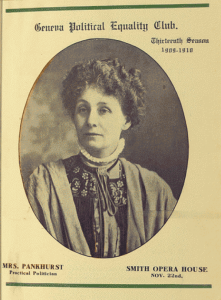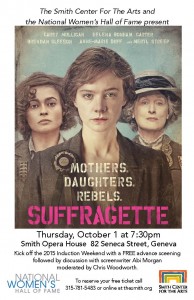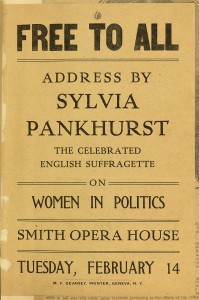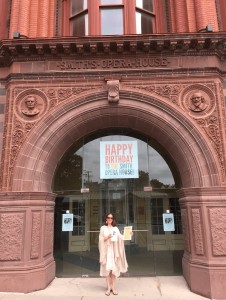SMITH HISTORY BLOG: Passionate Pankhursts: Suffrage at The Smith, Part II
by Chris Woodworth

Program cover from Emmeline Pankhurst’s November 22, 1909 speaking engagement at The Smith, presented under the auspices of the Geneva Political Equality Club.
In last week’s blog post, we discussed how Elizabeth Smith Miller and her daughter Anne Fitzhugh Miller brought suffrage to the stage of The Smith and eventually created the Geneva Political Equality Club. According to the Ontario County Historical Society, the Geneva Political Equality Club held regular meetings, hosted piazza parties at the Smith Miller home, organized a study club, and sponsored an array of high profile speakers. Two of the most iconic speakers presented under the auspices of the Geneva Political Equality Club were Emmeline Pankhurst and her daughter Sylvia. Visiting in 1909 and 1911, respectively, each of these women returned to The Smith in recent years, via contemporary proxies.
Emmeline Pankhurst (along with her other daughter Christabel) founded the Women’s Social and Political Union (WSPU) in 1903 in the UK. Sylvia was also a member but eventually broke ranks with the WSPU because of her concerns regarding their treatment of working-class women and labor issues. The WSPU was known for its militant protest strategies, which involved disruptions of public events, breaking windows, and even acts of arson. Suffragettes were often arrested for these deeds and would then go on hunger strikes, as they demanded to be treated as political prisoners. Scores of women were then violently force-fed. The turn of the century marked a period of transatlantic exchange for suffrage activists in the U.S. and the U.K. American suffrage proponents brought back some of the more militant and performative tactics after spending time in the U.K. and U.K. activists often traveled throughout the U.S., recounting their experiences. Emmeline Pankhurst’s 1909 North American speaking tour was partly a result of her friendship with Harriot Stanton Blatch, daughter of Elizabeth Cady Stanton and regular visitor to the Geneva Political Equality Club.

Poster from the advance screening of Suffragette in October 2015, co-sponsored by The Smith and the National Women’s Hall of Fame.
On November 22, 1909 Emmeline Pankhurst addressed an attentive audience at The Smith, which was decorated specially for the occasion. One article preserved in the Smith Miller Scrapbooks describes how the interior of the theatre was decorated with suffrage colors and banners of the Geneva Political Equality Club. In addition, “yellow chrysanthemums were used advantageously, while at the right of the stage was a portrait of Susan B. Anthony” (“Mrs. Pankhurst a Good Entertainer” 21). Mrs. Pankhurst addressed the legacies of the suffrage campaign in England, the transition to more militant tactics, and the brutal practice of forcible feeding following prison hunger strikes. Responses to her address were mixed. While one newspaper described her remarks as “rambling and ill-arranged” the writer also acknowledged, “she told the story of the woman movement in England in such a frank graphic manner that even the most ardent anti was interested” (“Mrs. Pankhurst a Good Entertainer” 21). The Geneva-Advertiser Gazette described her as someone who is “firm in her convictions and knows how to express herself” going on to note “she talked for considerably over an hour, with not a line of manuscript in front of her” and that “at times she was warmly applauded” (“Mrs. Pankhurst’s Address” 3). In 2015, Emmeline Pankhurst returned to The Smith, via Meryl Streep’s portrayal in the film Suffragette. The Smith Opera House teamed up with the National Women’s Hall of Fame to offer an advance screening of the film, followed by a Q&A with the screenwriter, Abi Morgan.

Flyer advertising Sylvia Pankhurst’s February 14, 1911 address at The Smith. The theme of her speech was “Women in Politics.”
On February 14, 1911, Sylvia Pankhurst, billed as “England’s Youngest Suffragette” spoke at The Smith to a near capacity crowd. Sylvia’s speech tackled an array of labor issues and recounted her own experiences in prison. The evening at The Smith was a full bill including an address by Geneva’s mayor, music by the Hobart College Quartet, hymns performed on a piano, and concluded with the taking up of a collection. Sylvia herself moved through the auditorium with a basket (“Miss Pankhurst Drew Big Crowd” 38). Sylvia was also the guest of honor at Lochland at a luncheon hosted by Anne Fitzhugh Miller. As British scholar Katherine Connelly notes in her introduction to the newly released edition of Sylvia’s memoir A Suffragette in America: Reflections on Prisoners, Pickets and Political Change, “North American-British lecture tours were a well-established phenomenon by the time Sylvia travelled to America in 1911. From the mid-nineteenth century, these tours became increasingly professionalised [sic.] and involved a prominent figure lecturing in various locations where they would be hosted and guided around local institutions and points of interest, often providing inspiration for further literary work” (Pankhurst 12). To celebrate the publication of Sylvia’s memoir, Connelly has embarked upon her own North American tour, visiting many of the sites where Sylvia spoke in 1911 and 1912. Among the stops was The Smith. She shares her reflections on her visit to Geneva on her own blog. Follow along as Sylvia Pankhurst once again travels throughout North America!

Photograph of British scholar Katherine Connelly holding her just-published copy of Sylvia Pankhurst’s A Suffragette in America: Reflections on Prisoners, Pickets and Political Change. Connelly edited this new edition and wrote a critical introduction to the text. She visited The Smith on June 18, 2019.
Works Cited
“Miss Pankhurst Drew Big Crowd.” Miller, Elizabeth Smith, Anne Fitzhugh Miller, and National American Woman Suffrage Association Collectio. Scrapbooks of Elizabeth Smith Miller and Anne Fitzhugh Miller, to 1911, 1897. Online Text. Retrieved from the Library of Congress, www.loc.gov/item/93838336, Vol. 7, p. 38.
“Mrs. Pankhurst a Good Entertainer.” Miller, Elizabeth Smith, Anne Fitzhugh Miller, and National American Woman Suffrage Association Collectio. Scrapbooks of Elizabeth Smith Miller and Anne Fitzhugh Miller, to 1911, 1897. Online Text. Retrieved from the Library of Congress, www.loc.gov/item/93838336, Vol. 6, p. 21.
“Mrs. Pankhurst’s Address.” Geneva-Advertiser Gazette, 25 November 1909, p. 3.
Pankhurst, E. Sylvia. A Suffragette in America: Reflections on Prisoners, Pickets and Political Change, edited and with an introduction by Katherine Connelly. Pluto Press, 2019.